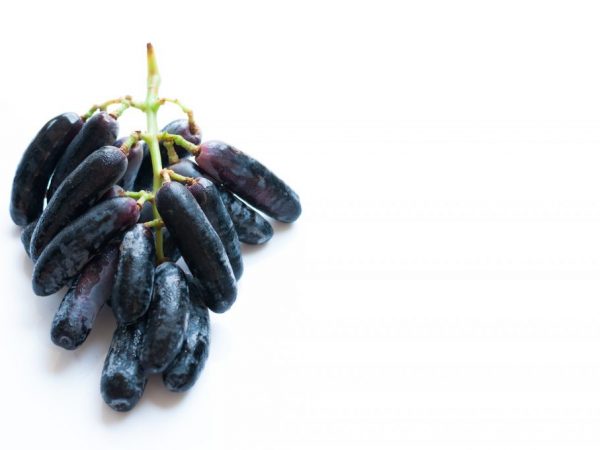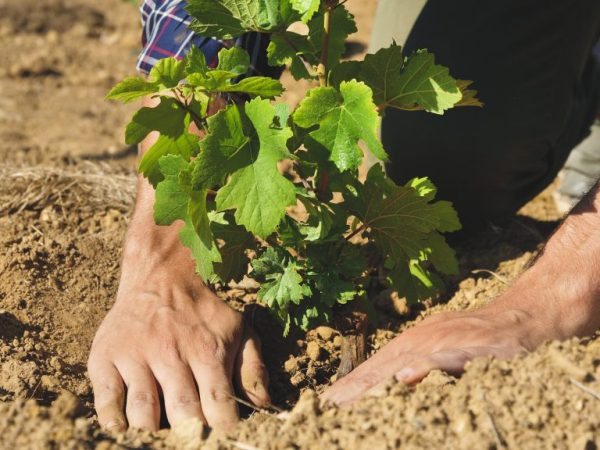Black Finger Grape
The Black Finger grape is a table species, the largest among the seedless late varieties. It was bred in Israel. In Russia, he has a double, Alyonushka.

Black Finger Grape
Variety characteristic
- The Black Finger grape variety has good taste. It resembles an ordinary white Kishmish. Because of its dark color, the people received the name black raisins.
- Grown in African countries and South America. Low frost resistance (up to -18-20 ° С).
- According to the description, the variety is thermophilic. It takes root well only in the southern regions of Russia.
- The yield is high.
- The ripening period is late.
- Full maturation occurs 145-150 days after the opening of the kidneys. Shoots ripen quickly. Harvesting begins in early October.
- The bisexual flowers ensure a high yield every year without any extra effort.
- Immunity to diseases is weak.
- High transportability and excellent storage makes the variety attractive for cultivation on industrial sites and in small garden plots. Transportation to areas remote from cultivation is possible.
Description of the bush
Features of the Black Finger grape bush:
- tall;
- leaves are massive;
- not prone to peas;
- up to 7-8 kg of berries ripen on each bush.
Description of fruits
Ripe, formed black toe grapes are attractive.
- berries fit tightly to each other;
- berries are large, oblong (up to 3.5 cm in length);
- berry weight 14-15 g;
- fruit color from dark blue to almost black;
- the shape of the bunch is asymmetric, in the form of an irregular cylinder;
- bunch weight from 600 g to 2 kg;
- the leg is treelike.
A characteristic feature of the variety is its taste, which is harmoniously balanced. Juicy pulp crunches pleasantly and leaves a nutmeg aftertaste. The rind is firm, but not firm.
Berries are characterized by a high sugar content - more than 22%.
Growing varieties
This hybrid variety is successfully cultivated in the southern regions. Low air humidity has a good effect on the yield, the berries never crack or spoil by bees. The vine is not covered. Grown in a large trunk.
Landing in the soil

It is recommended to plant grapes in spring
For Black Finger, it is preferable to choose the south side of the garden plot. According to the description, black raisins are capricious to light and humidity.
This species does not have any special requirements for the content of the soil. It grows well on different soils, but it is better if there is loose soil. Before planting, determine the height of groundwater. In the area reserved for the hybrid, they should not be located high. If the water zone is high, a system of its diversion is made to prevent decay of the rhizome.
Spring is the best planting time, autumn seedlings do not have time to take root before the cold weather. This is due to poor frost resistance.
For planting, they dig a hole in the fall measuring 70x80 cm and to a depth of 60-70 cm.A prepared nutrient mixture is poured into it, which consists of dug soil and fertilizers (organic and nitrogen-containing). Leave it in this form until spring.
At the beginning of March, with the onset of the first heat, a rack is installed in it, for further attachment of the vine to it.
The roots of the seedling are soaked in water for 4 hours. After that, set it in the center of the pit and sprinkle it with soil. Water with 4 buckets of water at room temperature so that the plant does not experience stress.
The root zone is mulched with sawdust or finely chopped bark. This action will protect the young sprout from weeds, and the soil around will not dry out prematurely.
Top dressing
Fertilization is carried out several times per season. Feeding begins with the growing season. Liquid mineral fertilizers are applied. Supplemented with solutions with minerals, which will stimulate the rapid growth of the leaf crown.
In the summer months, they are fed with potash and phosphorus fertilizers. They will ensure the formation of large ovaries. Ripening will be uniform and earlier.
The next top dressing is done in late autumn as a pre-winter preparation, when sap flow stops and the foliage is completely discarded. Add 1 bucket of compost under each bush.
Watering
Watering is carried out, focusing on the condition of the soil and air humidity. Plants do not tolerate waterlogging.
Under normal weather conditions, water 1 p. per month with standing water at room temperature in the morning or evening to avoid burns on the foliage.
Watering well with cold water leads to a shock of plants, after which its growth and development slows down.
After the next watering in the root zone, weeds are weeded and mulched. You cannot skip these procedures, because the soil will dry out, and the weeds will take away the nutrients necessary for the vineyard.
Disease prevention
For the prevention of diseases and pests, the foliage is treated monthly with solutions of fungicides and insecticides.
Timely pruning and formation of a leafy crown promotes high-quality ventilation, which protects the plant from fungal diseases, gray and black rot. At the same time, the total load on the bush is reduced (up to 35 eyes).
Conclusion
Subject to the requirements of agricultural technology, you can get a high-quality harvest even with minimal experience in viticulture. The grapes grown are used for different purposes. These fruits are good fresh, in juices or fruit salads, for winter preparations. Long-term storage allows you to enjoy summer berries in the cold season.


